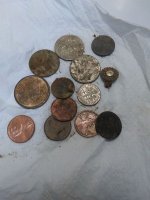I have a White's TDI that I bought to find gold nuggets. I havent got a chance to use it yet. I want to buy a VLF detector that is good for silver coins and also good for nuggets so that my daughter can use it with me. I have narrowed it down to Tesoro Lobo or Vaquero. I know the Lobo is made for gold but what exactly is different between it and the Vaquero? Can the Vaquero also find gold nuggets reasonabley well? I will be detecting in Oregon and Nevada mostly and possibley Arizona.
Upvote
0





